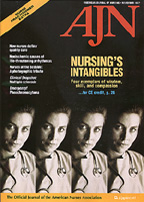November 1997
Volume 97, Number 11
ISSN:0002-936X

Coordinated by Mary Gorman, MS, CS, CARN
 Our medical unit treats a number of patients with cancer and AIDS who use
marijuana at home to relieve symptoms. They often want to continue the practice
while hospitalized. I don't want to contribute to their discomfort by stopping them,
but since marijuana is illegal I'm not sure what to do. I also wonder, how can I
tell the difference between someone who uses marijuana as a medicine and someone who uses
it to get high?
Our medical unit treats a number of patients with cancer and AIDS who use
marijuana at home to relieve symptoms. They often want to continue the practice
while hospitalized. I don't want to contribute to their discomfort by stopping them,
but since marijuana is illegal I'm not sure what to do. I also wonder, how can I
tell the difference between someone who uses marijuana as a medicine and someone who uses
it to get high? You're in a difficult position.
Marijuana is illegal, and laws against its use or possession are harsh. Users risk
arrest, fines or even jail time, forfeiture of property and loss of custody of children,
not to mention stress and legal costs. Nurses who help patients acquire or use
marijuana risk loss of license and job as well as criminal penalties. Hospitals
that allow the use of an illegal substance on their premises can also face legal
consequences.
You're in a difficult position.
Marijuana is illegal, and laws against its use or possession are harsh. Users risk
arrest, fines or even jail time, forfeiture of property and loss of custody of children,
not to mention stress and legal costs. Nurses who help patients acquire or use
marijuana risk loss of license and job as well as criminal penalties. Hospitals
that allow the use of an illegal substance on their premises can also face legal
consequences.
You might respond to patients who wish to use marijuana in the
hospital, "I'm sorry. I can't help you obtain marijuana, and hospital policy
does not allow you to use it here. I believe you when you tell me marijuana is
helpful to you. I will do everything I can to communicate your needs to your medical
team. Additionally, you can discuss with the team a trial use of dronabinol
(Marinol), a synthetic version of delta-9-tetrahydrocannabinol (THC), the primary
psychoactive constituent of marijuana. The drug has been approved by the FDA for
relieving chemotherapy-induced nausea and vomiting in cancer patients who don't respond to
conventional antiemetics and for stimulating appetite in patients with AIDS. If the
trial succeeds, the social worker can explore the manufacturer's assistance program for
the patient before he is discharged, should his insurance not cover the drug.
Use of the cannabis plant (marijuana) for symptom control has
gained increasing attention among both clinicians and the public. As nurses, we
realize that sometimes we use medicines that can be quite toxic - chemotherapeutic agents,
for example. Cannabis, by contrast, has a wide margin of safety, and throughout its
5,000 years of use a lethal overdose has never been documented.
In the late 1970s and mid-1980s six states conducted research on
marijuana's effectiveness for chemotherapy-induced nausea and vomiting and all concluded
that marijuana is an effective antiemetic. Cancer patients using marijuana report
immediate relief from chemotherapy-induced nausea and vomiting. AIDS patients with
wasting syndrome demonstrate increased appetite. Both groups of patients have
indicated a greater ability to cope emotionally with disabling or life-threatening
illness. While dronabinol represents a legal alternative to marijuana and one paid
for by insurers), patients don't experience the same degree of relief from the
pharmaceutical product. The cannabis plant contains numerous chemicals called
cannabinoids and it's believed that it's the combination of these - or specific
cannabinoids such as cannabidiol - that has therapeutic value, not the psychoactive
cannabinoid, THC.
You can support your patient who confides in you about his use of
marijuana by giving him clear and accurate information, thus minimizing potential physical
risks associated with the use of the drug. For example, contamination by mold --
especially Aspergillus -- can cause fatal lung infections in the
immunocompromised patient. You can advise the patient, "You need to be careful
about possible contamination. Baking marijuana at 300º for about 15 minutes may
slightly decrease the potency but will destroy any mold, which could otherwise cause a
serious infection, especially with your compromised immune status." You'll also
want to reduce any potential risks from smoking. You can discuss alternatives, such
as steeping tea with the marijuana or baking it in brownies. However, the oral route
may not be an option for patients who have severe nausea or who are vomiting.
Inhaling marijuana is efficient and allows for titration to the dose they need for
comfort. (This has been cited as an advantage of marijuana over dronabinol.)
Refer patients to related research (see Selected
References) for additional information.
Some patients may be using marijuana to get "high"
rather than for symptom control. The best way to know if a patient is using a drug
for therapeutic reasons is to ask. "Tell me about your use of marijuana.
When and how is it most helpful? How do its psychoactive properties affect
you? Are you ever uncomfortable using it?"
In addictions nursing the definition of addiction includes three
components: a compulsion to use; loss of control of use; and continued use despite
negative consequences. A thorough assessment of your patient's use of marijuana will
reveal whether these conditions exist.
In recent years, several state nurses associations and other
professional societies have issued resolutions or position papers in support of access to
marijuana for medical purposes. -- Mary Lynn Mathre, RN
- Mathre, M. L., ed. Cannabis in Medical Practice: A Legal, Historical, and Pharmacological Overview of the Therapeutic Use of Marijuana. Jefferson, NC, McFarland, 1997.
- Randall, R. C., ed. Marijuana, Medicine and the Law. Washington, DC, Galen Press, 1988-1989, vols. I-II.